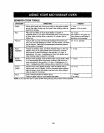
TIPS FOR MICROWAVE COOKING
BROWNING
Meat andpoultry withhigh fat content thatare cooked
for 10 or 15 minutesor longerwillbrownlightly. Foods
cookeda shortertimecan be brushedwitha browning
agent,suchas Worcestershiresauce,soy sauce, or
barbecuesauce.
COVERING
Acovertrapsheatand steamand causesthefood to
cookmorequickly.Usea lidor microwave-safeplastic
wrapwithonecornerfolded backto ventthe excess
steam.Lidsonglasscasserolescanbecomehot
duringcooking.Handlecarefully.Waxedpaperwill
preventthe food from splatteringinthe ovenand help
retainheat. Whenwarmingbreaditems,usewaxed
paper,napkins,orpapertowels.Toabsorb extra
moisture, wrapsandwichesand fatty foods in paper
towels.
SPACING
Arrange individual foods, such as baked potatoes,
cupcakes, and hors d'oeuvres in a circle and at least
t inch apart. This will help the food cook more evenly.
STIRRING
Stirringblends flavors and redistributes the heat in
foods. Always stir from the outside toward the center
of the dish. Food at the outside of the dish heats first.
TURNING
Large foods, such as roasts and whole poultry, should
be turned so that the top and bottom cook evenly. Also
turn over chicken pieces and chops.
ARRANGEMENT
Do notstack food. Arrange in a single layer in the dish
for more even cooking. Because dense foods cook
more slowly, place thicker portions of meat, poultry,fish,
and vegetables toward the outside of the dish.
TESTING FOR DONENESS
Because foods cook quickly in a microwave oven, you
need to test frequently for doneness.
STANDING TIME
Depending on density,food often needs to stand from 2
to 15 minutes after you remove it from the oven.
Usually, you need to cover food during standing time to
retain heat. Remove most foods when they are slightly
undercooked and they willfinish cooking during stand-
ing time. The internal temperature offood will rise about
10 °F during standing time.
SHIELDING
To prevent some portions of rectangular or square dish-
es from overcooking, you may need to shield
them with small strips of aluminum foilto block the
microwaves. You can also cover poultry legs and
wing tips withfoil to keep them from overoooking.
Always keep foil at least I inch from oven walls
to prevent arcing.
PIERCING
Pierce the shell, skin, or membrane of foods before
cooking to prevent them from bursting. Foods that
require piercing include yolks and whites of eggs, hot
dogs, clams, oysters, and whole vegetables, such as
potatoes_and squash.
CLEANING
Wipe the oven inside and outside with a soft cloth and
a mild detergent solution. Then rinse and wipe dry.
This should be done weekly or more often, if needed.
Never use cleaning powders or rough pads.
Excessive oil splatters on the inside top will be difficult
to remove if left for many days. Wipe splatters with a
wet paper towel, especially after cooking chicken or
bacon.
REMOVABLE PARTS
The turntable and turntable roller rest are removable.
They should be hand-washed in warm (not hot) water
with a mild detergent and a soft cJoth.Once they are
clean, rinse well and dry with a soft cloth. Never use
cleaning powders, steel wool, or tough pads.
• The turntable may be cleaned at the sink. Be careful
not to chip or scratch the edges as this may cause
the turntable to break during use.
• The turntable roller rest shouldbe cleaned ragulady.
SPECIAL CARE
For best performance and safety, the inner door panel
and the oven frontframe shouldbe free of food or
grease buildup. Wipe often with a mild detergent; then
rinse and wipe dry. Never use cleaning powders or
rough pads.
After cleaning the control panel, touch STOP/CLEAR
to clear any entries that might have been entered
accidentally while cleaning the panel,
9


















